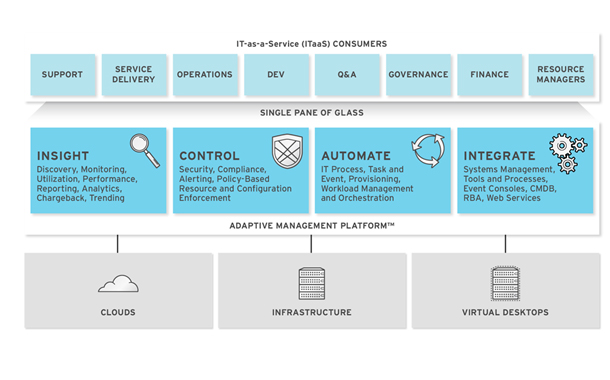Red Hat CloudForms 4.5 natively uses Ansible Playbooks to simplify service and policy definition as well as service lifecycle management.
Red Hat has announced a new, automation-centric approach to multi-cloud management with Red Hat CloudForms 4.5. As enterprise IT environments are transformed into dynamic, virtual infrastructures they introduce significant complexities around self-service, governance and compliance, resource management, financial controls and capacity planning. With Red Hat CloudForms 4.5, organizations can more quickly and easily publish fully automated IT services, providing their end users with policy-controlled self-service lifecycle management of their resources, while maintaining greater visibility and management capabilities for disparate resources.
Based on the open source ManageIQ project, Red Hat CloudForms is a multi-cloud management platform (CMP) that enables policy controlled self-service for consumers of IT services. It gives IT operations teams a system to detect and respond to environment changes by tracking activities, capturing events and detecting configuration changes. CloudForms also provides IT organizations with the ability to monitor utilization and capacity via customizable policies for governance and compliance enforcement, as well as tools for IT financial management by using consumption data and billing rates to generate chargeback reporting.
Ansible by Red Hat is a simple, powerful and agentless open source IT automation platform that enables entire teams to automate repetitive tasks using a simple, human-readable language. It helps to define and manage the systems, network devices, applications, and tools that enterprise IT organizations are using today, driving down complexity by describing infrastructure and processes in Ansible Playbooks, which are then run by the powerful Ansible automation engine.
Red Hat CloudForms 4.5 natively integrates Ansible, taking an industry-first automation-based approach to multi-cloud management. This is designed not only to make Red Hat CloudForms more easily deployable across an organization, but also to provide customers with far more readily available integration points, increasing the depth and breadth of automation for their IT service management needs. This integration is aligned with Red Hat’s vision to simplify IT management with Ansible’s powerful automation capabilities.
Highlights of the Ansible integration with Red Hat CloudForms 4.5 include:
- Service Catalog – Service catalog items can now consist of Ansible Playbooks in addition to OpenStack Orchestration (Heat) templates, Amazon Web Services (AWS) CloudFormation, Microsoft Azure Stack, VMware vApp and more, enabling administrators to more rapidly define and publish a greater number of services for their users.
- Governance – Administrators can now use Ansible Playbooks to enforce many different IT policy models and more easily assess that deployed systems are staying compliant, enforce security standards and optimize resources.
- Access to the Ansible ecosystem – More than 10,000 pre-built Ansible Playbooks and more than 1,000 integration modules can now be directly used in Red Hat CloudForms, delivered as IT services and used for policy enforcement and compliance.
Automation is an essential component of strategic modernization and digital transformation, especially for dynamic IT environments that require a new type of management solution. A growing number of organizations around the world are starting to standardize on Ansible for automation. By bringing Ansible automation across its management portfolio, including Red Hat CloudForms for multi-cloud management, Ansible Tower for centralized automation governance, and Red Hat Insights for predictive analytics, Red Hat is delivering strategic management and automation capabilities to enterprises.
As per the release, Red Hat CloudForms 4.5 is expected to be generally available in the Red Hat Customer Portal.
Joe Fitzgerald, vice president, Management, Red Hat said, “Ansible has become a strategic technology with increased adoption and community growth with industry-leading automation capabilities. Driving native Ansible support into Red Hat CloudForms was an obvious next step to provide a higher degree of automation in a multi-cloud management solution. Red Hat CloudForms already provided comprehensive cloud management capabilities and with native Ansible support, we take it a step further with human-readable automation language, greatly simplifying the building of solutions to deploy, manage, optimize and bolster security for hybrid and multi-cloud deployments.”


